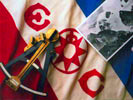|
Members
- Roster
Page
- Member's Biographies
- Member's
Books and Videos
- Awards
- Student
Members
- Past
Members
Expeditions
- Member
Expeditions
- Media Coverage
- Historic Greater
Piedmont Explorers
Explorers
Club Resources
- Expedition
Planning
- Expedition
Funding
- Field Science Sites
- Field Research Centers
Join
The Explorers
- Become
a Member
-
About the Club
- Chapter Leadership
- Club Chapters
History
- Chapter History
- The Explorers Club Journal
Contact
Us
- Explorers
Club
- Explorers
Club HQ
Contact
Us
- Explorers
Club
- Explorers
Club HQ
|
About
The Explorers Club
From The
Explorers Club Canadian Chapter:

Scott's 1910-13
Antarctic hut |
The Explorers Club is an international
multidisciplinary, professional society dedicated to the advancement of
field research and scientific exploration, and the ideal that it is
vital to preserve the instinct to explore. Since its inception in 1904
, the Club has served as a meeting point and unifying force for
explorers and scientists worldwide. In addition to its headquarters
building at 46 East 70th Street in New York, the Club has some 30
regional chapters in the United States and abroad.
Promoting Exploration Since 1904
The Explorers Club promotes the scientific exploration of land, sea,
air and space by sponsoring, assisting and encouraging research and
education in the physical, natural and biological sciences. The Club
offers a number of financial grants and awards and offers assistance to
members in expedition planning. The Explorers Club actively encourages
public interest in exploration and the sciences through its public
lectures program, publications, travel program, and other events. The
Club also maintains a library and map room to assist those interested
and engaged in exploration and scientific research.
Anthropologists to Zoologists
The Explorers Club is characterized by the great diversity of its
members' backgrounds and interests. The seven founding members included
two polar explorers, the curator of birds and mammals at The American
Museum of Natural History, an archaeologist, a war correspondent and
author, a professor of physics and an ethnologist. Today the membership
includes field scientists and explorers from over 60 countries whose
disciplines include: aeronautics, anthropology, archaeology, astronomy,
biology, ecology, entomology, mountaineering, marine biology,
oceanography, paleontology, physics, planetology, polar exploration,
and zoology. The Explorers Club has many chapters throughout the United
States and abroad. You can find out more about what our members are
doing in the news & research pages or by visiting members' web
pages linked to this site.
History
of The Explorers Club
The year
was 1904. The spirit of exploration was running high. Theodore
Roosevelt, America’s premier adventurer President, was still in the
White House. The Wright Brothers’ flying machine was barely off the
ground; air travel was years away from reducing the globe to an
accessible sphere. A few explorers determined to reach the North Pole
had captured the imagination of the Western world. Many geographic
regions remained undiscovered. Spurred by the challenges of reaching
the unreachable and the scientific desire to pry from the earth its
long-held secrets, a hardy band of gentleman-adventurers came together
to form The Explorers Club in New York City.
The idea
began with Henry Collins Walsh, an author and war correspondent who had
sailed with Frederick A. Cook’s 1894 Arctic expedition aboard the
ill-fated SS Miranda. On their return to New York, Walsh and his fellow
survivors, eager to “keep green their friendship,” organized the Arctic
Club, which came to embrace nearly every prominent polar explorer in
the United States and abroad. So successful was it that a core of its
members, together with friends who had explored in other regions,
decided to found the more inclusive Explorers Club. The charter members
were a diverse group representing a myriad of interests and walks of
life. Their stated mission: “promote exploration by all possible
means.”
Incorporated
in 1905, The Explorers Club in its earliest years met in simple rented
rooms. Its first four presidents were famed Arctic explorers Adolphus
W. Greely, Cook, Robert E. Peary and David L. Brainard. Under Brainard
in 1912, the Club found a permanent home in a loft on Amsterdam Avenue.
There, members began holding regular meetings and gala dinners and
assembling the books, maps, trophies and memorabilia that would grow
into a remarkable library and museum of exploration and travel.
Returning explorers and visiting scientists were invited to share their
experiences in public and member lectures. By the 1920s, the Club was
aiding serious exploration and field science.
In 1965,
the Club purchased a Tudor-style mansion on East 70th Street, in the
historic Upper East Side. With its twin-arched façade of brick and
limestone, leaded glass windows and carved oak interiors, the Lowell
Thomas building, named for the noted explorer and broadcaster, has
become the physical symbol of the Club’s high purposes, embodying the
history of exploration and the passionate quest for new knowledge.
Frey,
Joseph, “Putting The World On The Map”, Outpost: Canada’s Travel
Magazine, March/April 2003
(View
PDF)
Explorer's Club Charter
Since
1904, our international, professional society has been a meeting point
and unifying force for explorers and scientists worldwide. The
Explorers Club is dedicated to the advancement of field research,
scientific exploration, and the ideal that it is vital to preserve the
instinct to explore. We foster these goals by providing expedition
planning assistance, research grants, educational lectures and
publications, and exciting adventure travel programs.
Explorers Club Charter
(PDF file)
|



